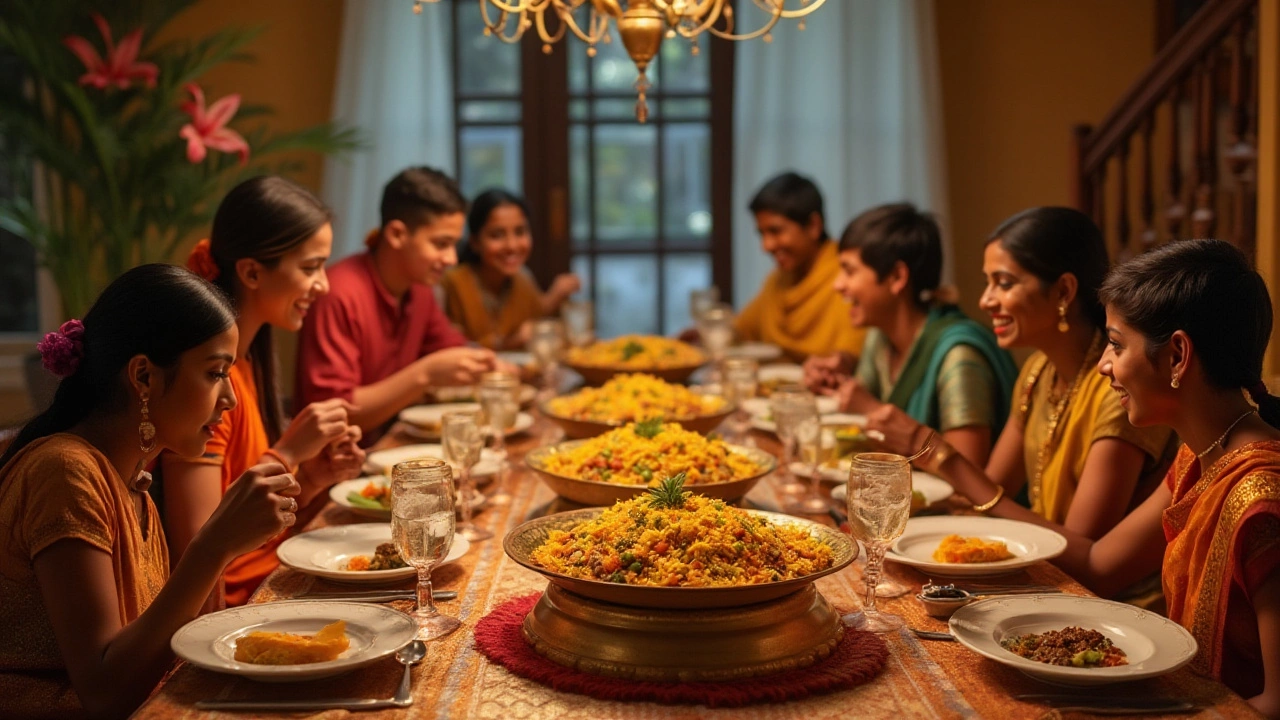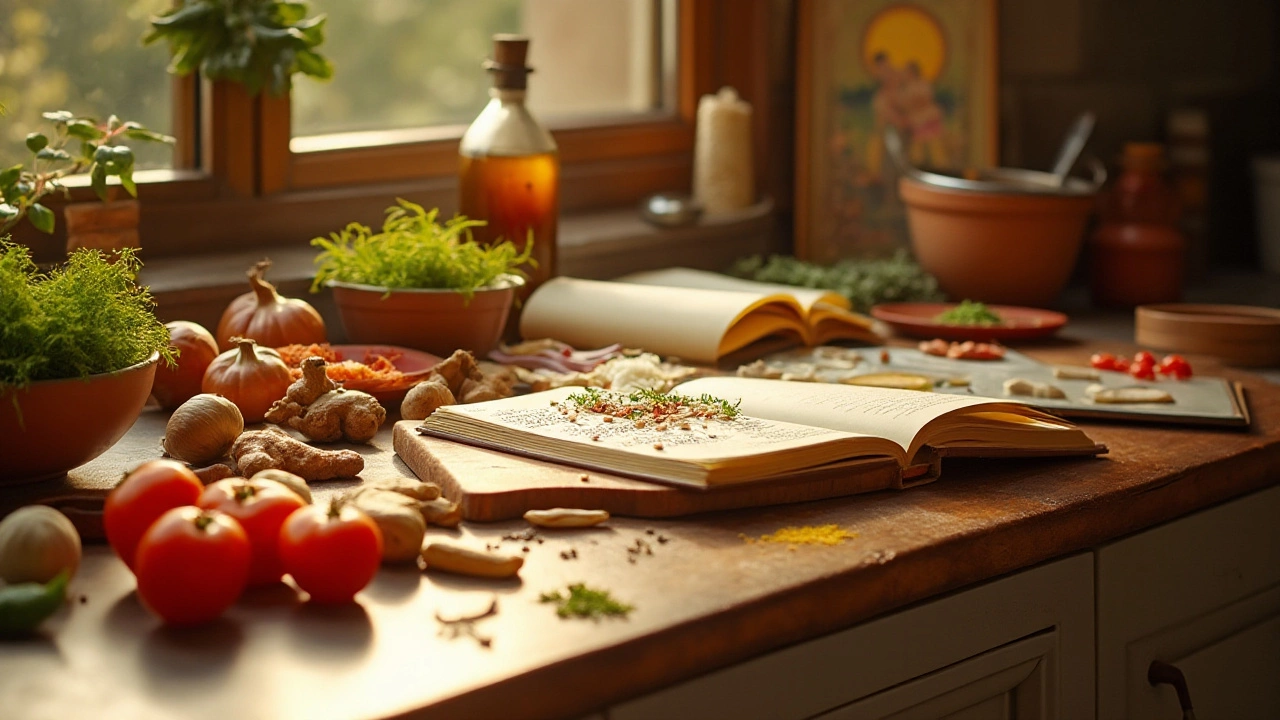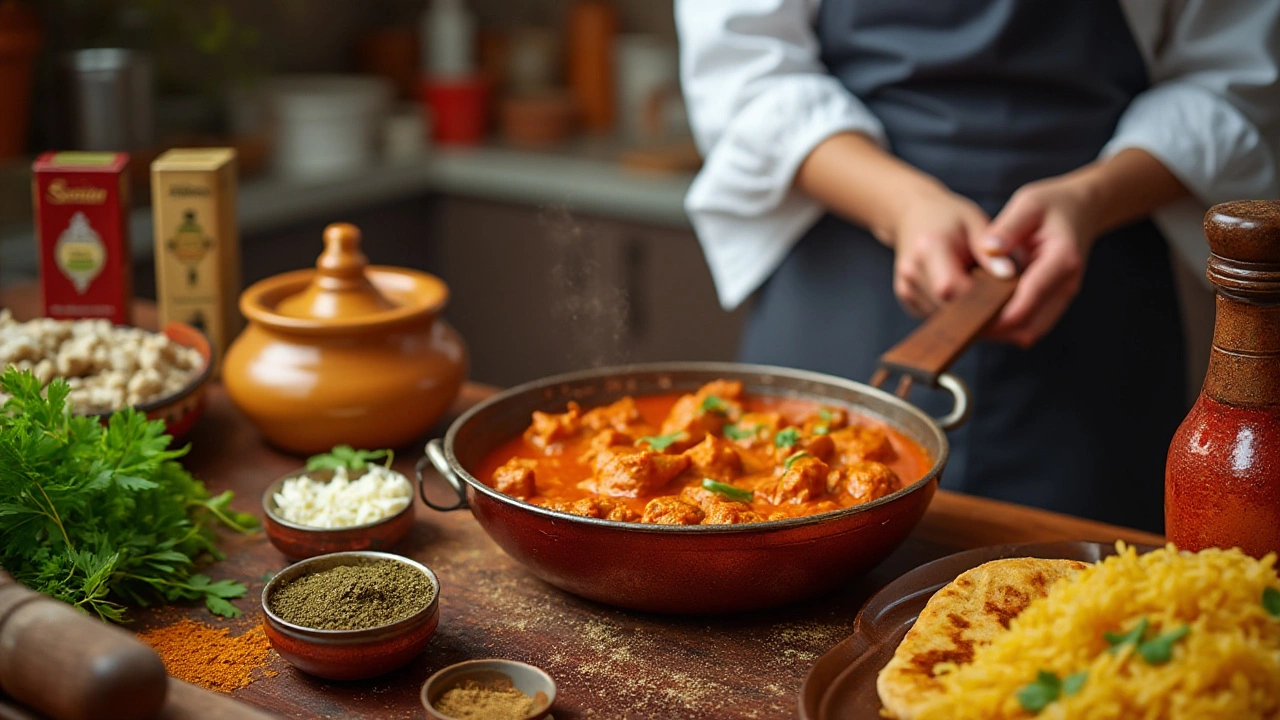Planning a dinner party for your American friends and want to infuse a little Indian flavor into the mix? Cooking Indian food that appeals to a Western palate can be both fun and rewarding. The key is choosing dishes that highlight the rich spices and vibrant flavors of Indian cuisine while ensuring they are approachable and not overly spicy for your guests.
In this guide, we'll explore a variety of Indian recipes that are sure to please any crowd. From delightful starters to mouth-watering main courses, we'll walk you through easy recipes that are full of flavor and warmth. By the end of this article, you'll be ready to create an unforgettable culinary experience that bridges the taste of India with American sensibilities.
- Understanding American Preferences
- Starter Selections
- Main Courses to Impress
- Side Dishes and Accompaniments
- Sweet Treats to Conclude
- Useful Tips and Ingredients
Understanding American Preferences
When inviting Americans to enjoy traditional Indian cuisine, it's crucial to understand their taste preferences to ensure a delightful dining experience. Generally, American palates appreciate dishes that are flavorful yet subtle in heat. While spices are warmly welcomed, overwhelming spiciness can be off-putting, especially for those unfamiliar with the vibrant heat typical of Indian cooking. This means you may need to adjust the spice levels—or offer a range of condiments, like yogurt-based raita, to cool the palate. By tailoring the spice, you promise an experience that’s both authentic and enjoyable.
In addition to managing spice levels, consider the culinary styles that are most popular in America. Many Americans have been introduced to Indian food through popular dishes like chicken tikka masala, which is both creamy and mildly spiced. This combination of familiar flavors in a new context can make guests more open to trying traditional recipes they’ve never tasted. On the flip side, be mindful of dietary preferences, as an increasing number of people are opting for vegetarian or vegan lifestyles. Incorporating dishes like vegetable biryani or paneer tikka can accommodate these choices while still delivering powerful taste sensations.
Americans often enjoy meals that embrace communal dining, where sharing various dishes at once is encouraged. This aligns wonderfully with the Indian concept of thali—a platter that features a variety of small portions of different dishes. Presenting an Indian meal as a shared experience not only facilitates conversation but also allows your guests to sample a wide range of textures and flavors, ensuring there's something for everyone. As is the case with tapas in Spain or sushi in Japan, this type of meal invites participation and enjoyment in the moment.
As Chef Madhur Jaffrey, a respected figure in popularizing Indian cuisine in the West once remarked,
"The wonders of Indian cooking lie in its variety, the untold secrets of flavor combinations that people are only just beginning to discover."This approach to cooking can turn a simple dinner into an exploration of tastes. Her sentiment echoes the importance of introducing American diners to Indian food gradually, with each dish acting as a stepping stone to more complex flavors and ingredients that they might not typically encounter.
Starter Selections
When it comes to crafting an enticing start to your Indian meal, there are iconic dishes that never fail to entice and satisfy the taste buds. Consider beginning with something light yet flavorful, such as the classic Indian appetizer, Samosas. These triangular pastries are loaded with a spiced mixture of potatoes, peas, and sometimes minced meat, all wrapped up in a thin, crisp shell. They strike the perfect balance between a light snack and a flavorful introduction to the rest of the meal. Serving them with tangy tamarind chutney or mint yogurt dip can enhance the taste even more, pleasing any American guest who may be new to these delightful flavors.
Another fantastic option to consider is Paneer Tikka, which is especially great for vegetarians. Cubes of paneer cheese are marinated in a mixture of yogurt and spices, including cumin, coriander, and garam masala, which imbue the dish with rich, earthy flavors. These cubes are then skewered and grilled or baked until they are lightly charred and smoky. The soft, creamy texture of paneer makes it a hit with those unfamiliar with Indian cuisine. Serving these tikkas with a sprinkle of chaat masala and a side of lemon wedges can add a zing that elevates the entire dish.
A popular crowd-pleaser that's slightly off the beaten path is Papdi Chaat, a beloved street food from India that combines a variety of textures and flavors. It's a vibrant medley of crisp fried dough wafers (papdi), boiled potatoes, chickpeas, chutneys, and yogurt topped with crunchy sev. This dish isn’t just a feast for the taste buds; it's a visual treat as well. The layering of different components offers an unexpected burst of flavors that make it both intriguing and irresistible. According to Chef Vineet Bhatia, "Chaat captures the culinary spirit of India with its bold flavors and textures, making it a rapturing starter for those who experience it for the first time."
Finally, consider providing a refreshing dish like Cucumber Raita. This yogurt-based dish is often overlooked but can be the soothing balm to any spicy meal component. Made from plain yogurt mixed with grated cucumber and flavored with cumin and a hint of salt, raita can be dressed up with finely chopped mint or coriander to offer an aromatic touch. It's simple yet incredibly effective in cooling down the palate, making it an exceptionally complementary starter. This light side dish can set the stage for the spicy delights that follow, ensuring your American guests enjoy their meal without being overwhelmed by heat.
The secret to indulging American guests with Indian starters lies in selecting dishes that are both authentic and adaptable. By choosing options that highlight the diverse array of textures and flavors like crispy samosas, smoky paneer tikka, savory chaat, and smooth raita, you can ignite curiosity and excitement among your guests and prepare them for the culinary journey ahead. Experiment with presentation, play with condiments, and watch as these flavorful bites open up new possibilities in the dining experience you offer.

Main Courses to Impress
The main event of any dinner party is, of course, the entrée. When cooking Indian cuisine for American guests, it's essential to strike a balance between authenticity and accessibility. One dish that consistently impresses is the ever-popular Chicken Tikka Masala. Famous for its creamy sauce and tender chicken, this dish incorporates a medley of spices like cumin, coriander, and garam masala, blended with a rich tomato base and finished with a touch of cream. It’s believed to have roots both in traditional Indian cooking and British culinary adaptation, making it an ideal bridge between the two cultures.
"Having Chicken Tikka Masala is like tasting Indian culture combined with British soul in a single dish," suggests food historian Lizzie Collingham.
Another crowd-pleaser is Lamb Rogan Josh, known for its aromatic spices and succulent lamb. Originating from the Kashmir region, this dish uses slow-cooked lamb heavenly spiced with cardamom, cinnamon, and a hint of Kashmiri chili, providing warmth without overwhelming heat. Paired with steamed basmati rice or fluffy naan, it’s a staple you can count on to delight your guests. Remember, the secret lies in letting the lamb simmer long enough to soak up the flavors and become tender.
For vegetarians, Paneer Butter Masala offers a delectable alternative. This dish is characterized by its luscious, buttery gravy and soft cubes of paneer, an Indian cheese. Simmered gently with a mixture of tomatoes, cream, and essential spices like fenugreek, it’s rich enough to satisfy even the most ardent meat-lovers. As a tip, ensure your paneer is fresh or homemade—as fresh paneer absorbs flavors much better and enhances the dish's overall taste.
| Main Course | Cooking Time | Spice Level |
|---|---|---|
| Chicken Tikka Masala | 40 minutes | Medium |
| Lamb Rogan Josh | 2 hours | Medium |
| Paneer Butter Masala | 30 minutes | Mild |
Lastly, Vegetable Biryani can be a perfect one-pot wonder to round off the meal. Packed with assorted vegetables, this rice dish is fragrant and colorful, featuring saffron's warm hues and spices like cloves and bay leaves. Traditionally, biryanis are a blend of Mughlai and South Indian influences, symbolizing the rich tapestry of Indian culinary heritage. Ensure it's cooked with fresh vegetables and quality basmati rice to maximize both flavor and texture. This incredibly versatile dish can effortlessly adapt to particular tastes or dietary restrictions, making it a solid contender for any gathering.
Side Dishes and Accompaniments
When hosting a meal that showcases the best of Indian cuisine, the main course often steals the spotlight. However, the right side dishes and accompaniments can truly elevate the dining experience, enhancing the flavors and providing a delightful contrast to the main attractions. Side dishes in Indian cooking are not merely add-ons; they are integral parts of a meal, carefully crafted to balance the meal's texture and taste.
One classic side dish that pairs wonderfully with almost any main course is the humble yet captivating Raita. This refreshing yogurt-based dish, seasoned with spices like cumin and garnished with cucumbers or mint, acts as a cooling balance to spicier elements on the plate. What makes Raita particularly appealing is its versatility. Whether you’re serving a rich curry or a light biryani, a well-made Raita can provide a refreshing contrast that complements the meal.
Indian food is also known for its array of Indian breads, each bringing its own unique flavor to the table. Naan, soft and buttery, is a popular choice among Western guests. Perfect for scooping up curries or pairing with kebabs, Naan can be easily made at home or bought from a local store. A seasoned cook might also experiment with stuffed variants like garlic or cheese naan, which add an extra layer of flavor. For a healthier alternative, Roti or Chapati makes an excellent choice. These unleavened flatbreads can be made using whole wheat flour and pair well with any dish laden with gravies.
| Side Dish | Main Ingredient | Complimentary Dishes |
|---|---|---|
| Raita | Yogurt | Curry, Biryani |
| Naan | Flour | Veg/Non-Veg Curry |
| Chutney | Tamarind, Coconut | Snacks, Starters |
Chutneys also form an essential part of Indian side dishes. These thick sauces range from sweet to spicy and can be made with ingredients like tamarind, mint, or coconut. Tamarind chutney, with its sweet and tangy notes, pairs exceptionally well with fried snacks, while mint chutney offers a zesty companion to tikkas and kebabs. As an oft-quoted phrase in Indian households goes, “A good chutney can turn any meal into a feast.”
"Chutneys are like little bursts of flavor that enhance every bite," says Madhur Jaffrey, acclaimed Indian food writer.
Combining sides thoughtfully adds depth to your cooking, offering varied textures and flavors. It's not just about the taste; it's the vibrant, colorful contrast that brings life to the table setting. Pairing the fiery kick of spicy potatoes with the creamy coolness of Raita or the earthy taste of Dal with aromatic Basmati rice are examples of balance at play. __When you plan your menu__, never underestimate the importance of these delectables. They turn any simple meal into a delightful culinary journey across India.

Sweet Treats to Conclude
As your delightful Indian feast begins to wind down, it's time to think sweetly and dive into the magical world of Indian desserts. Known for their unforgettable sweetness and rich textures, Indian desserts provide the perfect finish to any meal, especially when shared with American guests. Let's explore a few iconic Indian sweets that are simple to make and guaranteed to put smiles on faces. One of the most beloved is Gulab Jamun. These soft, warm dumplings, made from khoya, are soaked in a rose-scented sugar syrup. Legend has it that Gulab Jamun was inspired by the Indian confectioner of the Mughal emperors, serving them as a sign of opulence and hospitality. Their delightful sweetness is often likened to that of caramel combined with a floral twist, making them a perfect match for the Western palate.
Another irresistible creation is Kheer, a traditional rice pudding that can be likened to a creamy bowl of comfort. Rice, milk, and sugar form the base of this delectable dessert, which is then delicately spiced with cardamom and adorned with nuts such as cashews and almonds. Kheer's simplicity surpasses its ingredients' worth, as it brings together flavors that harmoniously dance upon the tongue. A bowl of warm kheer often reunites family gatherings, marking celebrations with its comforting aroma. A respected chef and food writer once said,
“Kheer embodies a quiet celebration in each spoonful, a testament to the humble grain of rice elevated to royal splendor.”This can be an excellent opportunity for your guests to indulge in an authentic Indian dessert that feels both exotic and familiar.
For those who fancy a shorter preparation time, Barfi is a delightful option. Barfi, also known as Indian fudge, is a confection made primarily from condensed milk and sugar, with a myriad of flavor variations. Pistachio, coconut, and almond are popular choices, each providing their unique taste. Traditionally made during Indian festivals, barfi carries an aura of festive cheer and can often be adorned with silver leaf, which adds a touch of royalty. Not only does it satisfy a sweet craving, but it also presents beautifully on the table, making it a visual and taste delight for your guests. The magic of Indian desserts lies in their ability to be both an everyday treat and a celebration centerpiece.
To add a dash of vibrant color to your dessert spread, why not try Ras Malai? This dessert features soft paneer cheese balls embedded in creamy, cardamom-infused milk, colored delicately with saffron. Every bite is a symphony of softness and sweetness, as the syrupy milk allows the cheese to melt in your mouth. Ras Malai is often reserved for special occasions and family gatherings, yet its preparation is simple enough for any kitchen table. Here is an interesting tidbit: saffron used to garnish Ras Malai is actually the world’s most expensive spice by weight! This gives guests not just a dessert but a story to take away. Highlighting the origin of such ingredients provides a narrative element to the dining experience, making it more than just a meal, but a cultural conversation.
For those desiring a bit of crunch, consider preparing Jalebi, a swirly, crispy dessert that's made by deep-frying flour batter soaked in syrup. It is beautiful in its complexity, present in vibrant orange rings. They can be eaten hot or cold and make for an exciting sweet surprise due to their unique texture and appearance. Jalebi is often enjoyed during Indian celebrations, bringing a sense of buoyancy and joy to the event. As you prepare these crispy, orange spirals of happiness, your kitchen may well resonate with the excitement usually felt in bustling Indian streets during festivals. A plate of fresh jalebi, with its bright colors and sweet taste, can round off your Indian culinary showcase with a memorable flourish.
Useful Tips and Ingredients
When it comes to preparing Indian cuisine for an American audience, there are a few essential tips and ingredients that can elevate your dishes to the next level. First and foremost, consider the spice levels. While Indian food is celebrated for its wide range of spices, it's essential to tailor the spiciness to cater to your guests' preferences. Not everyone has the same tolerance for the heat of a green chili or the pungency of black pepper. It's always a good idea to start with milder flavors, offering hot sauces or chopped chilies on the side for those who prefer a little extra kick. Keep a variety of spices like cumin, coriander, and turmeric at hand, as they form the backbone of many Indian dishes.
Ingredient authenticity is another cornerstone of successful Indian recipes. Ingredients such as garam masala, an aromatic blend of spices, and kasuri methi, dried fenugreek leaves, can add depth and authenticity to your dishes. If you’re sourcing these spices in the UK or US, try to find an Indian grocery store for the freshest and highest-quality products. Fresh coriander leaves are an excellent addition to most dishes, providing both color and a burst of flavor. Don't forget staple ingredients like garlic, ginger, and onions. These aromatic ingredients are used in the preparation of most dishes and lay the flavor foundation for curries and gravies.
One of the key tips is to master the art of tempering spices. Known as 'tadka' or 'chaunk,' this technique draws out the aromatic oils in spices and infuses flavor throughout your dish. Heat oil or ghee in a pan, then add mustard seeds, cumin seeds, or curry leaves until they pop, releasing their fragrance. Using this method can truly bring out the heart of Indian food. According to Madhur Jaffrey, a noted authority on Indian cuisine, "A well-executed tadka can transform a simple dal into a divine experience."
Finally, balancing your menu with a mix of flavors and textures is crucial. Include both spicy and mild options, rich and light dishes, and a variety of textures, from crispy samosas to silky-smooth curries. This not only caters to diverse palates but also provides a comprehensive introduction to the diverse tapestry of Indian food culture. Keep in mind dietary restrictions or preferences, such as vegetarianism, which is prevalent in India. Store-bought paneer or chickpeas can make excellent meat substitutes and are staples in Indian vegetarian cooking.
